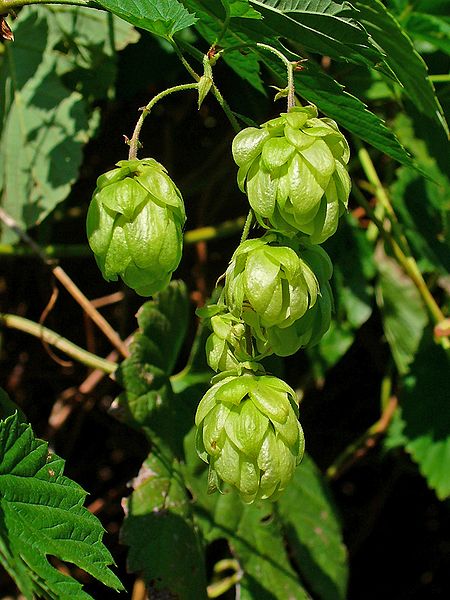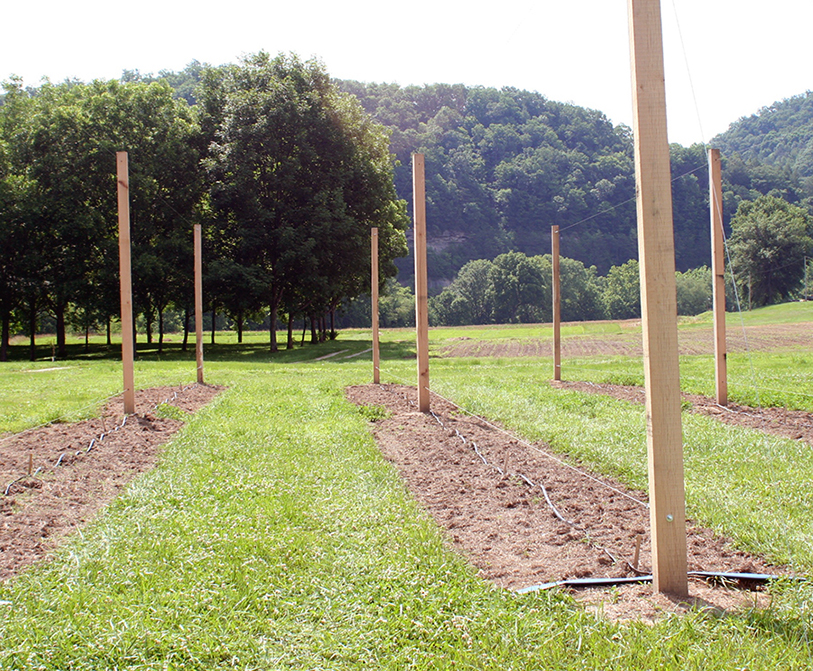Hops
Hop (Humulus lupulus) is an herbaceous plant with a perennial crown and annual climbing stems (bines). Hop crowns can survive for 25 years or more; however, the fast growing bines die back to the ground each winter. Bines can reach a height of 15 to 30 feet in a single growing season. Hops are valued for their female cones, which contain the resins and essential oils used to provide the distinctive flavor and aroma to beer.
Marketing
 Hops have a limited, yet potentially profitable market in Kentucky. Major U.S. breweries generally purchase domestic hops from wholesale brokers. This market is usually available only to producers who can supply large quantities of hop cones. However, the increasing numbers of craft breweries and brewpubs in the U.S. has created market potential for small growers. Craft breweries are smaller breweries that produce less than 6 million barrels annually and typically sell their product off-premises. Brewpubs, on the other hand, are small breweries that are connected with a restaurant and/or bar. Both generally produce specialty beers, often with regional appeal. Small-scale growers might provide these specialty breweries with the desired cultivars of high quality, freshly harvested or processed hops not otherwise available to the small brewery. Direct sales to these smaller breweries will generally require establishing an ongoing business relationship from production to harvest. Growers with small acreages could also market their product directly to home brew shops, hobby brewers, specialty stores, and specialty non-beer product markets.
Hops have a limited, yet potentially profitable market in Kentucky. Major U.S. breweries generally purchase domestic hops from wholesale brokers. This market is usually available only to producers who can supply large quantities of hop cones. However, the increasing numbers of craft breweries and brewpubs in the U.S. has created market potential for small growers. Craft breweries are smaller breweries that produce less than 6 million barrels annually and typically sell their product off-premises. Brewpubs, on the other hand, are small breweries that are connected with a restaurant and/or bar. Both generally produce specialty beers, often with regional appeal. Small-scale growers might provide these specialty breweries with the desired cultivars of high quality, freshly harvested or processed hops not otherwise available to the small brewery. Direct sales to these smaller breweries will generally require establishing an ongoing business relationship from production to harvest. Growers with small acreages could also market their product directly to home brew shops, hobby brewers, specialty stores, and specialty non-beer product markets.
Production
 Planning a hopyard can be likened to planning an orchard because of the long-term nature of the enterprise. Careful thought and preparation needs to go into selecting and preparing a suitable site. Although hop plants may survive 25 years or more, growers often choose to replant after about 10 to 15 years as brewer demand changes. Select a fertile, well-drained, sunny site with access to water for drip irrigation. Hops require plenty of water during the growing season, but it is critical to avoid wetting the plants themselves due to some potentially devastating disease problems. While winds in the spring to mid-summer provide good air circulation and thus allow plant foliage to dry, winds later in the season can damage the ripening cones. Therefore, it is important to situate the planting with the prevailing winds to your advantage. If necessary, windbreaks can aid in preventing excessive cone injury. Fields should be well-prepared the year prior to planting the yard. Have a soil test conducted and add lime, phosphorus and potassium as needed. Control perennial weeds. Have the soil tested for nematodes. Raised beds should be constructed if needed. The trellis system can also be set up at this time. Hops must be grown on a trellis system to obtain high yields. Bines growing vertically produce more flowers than those growing horizontally; thus, taller trellis systems result in more vertical plant growth and, therefore, more flowers. The overhead trellis system is most often used for commercial production, particularly in hop yards of more than one-half acre. This system can be constructed of metal, which will require fewer poles than a wooden system. Another advantage of the metal system is that the materials can be recycled when the yard is finally removed. Metal trellis systems also are lighter than wooden poles and easier to erect. A wooden pole system can also be used, and this elaborate 16- to 18-foot-high system consists of a number of wooden poles buried 3 to 4 feet into the ground approximately every five plants. Cedar poles are most frequently used; however, fir or pine poles treated with a preservative are also common. The poles are connected by overhead wire cables that run both down and across the rows, although some growers just run the wires down the rows.
Planning a hopyard can be likened to planning an orchard because of the long-term nature of the enterprise. Careful thought and preparation needs to go into selecting and preparing a suitable site. Although hop plants may survive 25 years or more, growers often choose to replant after about 10 to 15 years as brewer demand changes. Select a fertile, well-drained, sunny site with access to water for drip irrigation. Hops require plenty of water during the growing season, but it is critical to avoid wetting the plants themselves due to some potentially devastating disease problems. While winds in the spring to mid-summer provide good air circulation and thus allow plant foliage to dry, winds later in the season can damage the ripening cones. Therefore, it is important to situate the planting with the prevailing winds to your advantage. If necessary, windbreaks can aid in preventing excessive cone injury. Fields should be well-prepared the year prior to planting the yard. Have a soil test conducted and add lime, phosphorus and potassium as needed. Control perennial weeds. Have the soil tested for nematodes. Raised beds should be constructed if needed. The trellis system can also be set up at this time. Hops must be grown on a trellis system to obtain high yields. Bines growing vertically produce more flowers than those growing horizontally; thus, taller trellis systems result in more vertical plant growth and, therefore, more flowers. The overhead trellis system is most often used for commercial production, particularly in hop yards of more than one-half acre. This system can be constructed of metal, which will require fewer poles than a wooden system. Another advantage of the metal system is that the materials can be recycled when the yard is finally removed. Metal trellis systems also are lighter than wooden poles and easier to erect. A wooden pole system can also be used, and this elaborate 16- to 18-foot-high system consists of a number of wooden poles buried 3 to 4 feet into the ground approximately every five plants. Cedar poles are most frequently used; however, fir or pine poles treated with a preservative are also common. The poles are connected by overhead wire cables that run both down and across the rows, although some growers just run the wires down the rows.
See the full crop profile and other resources below:

